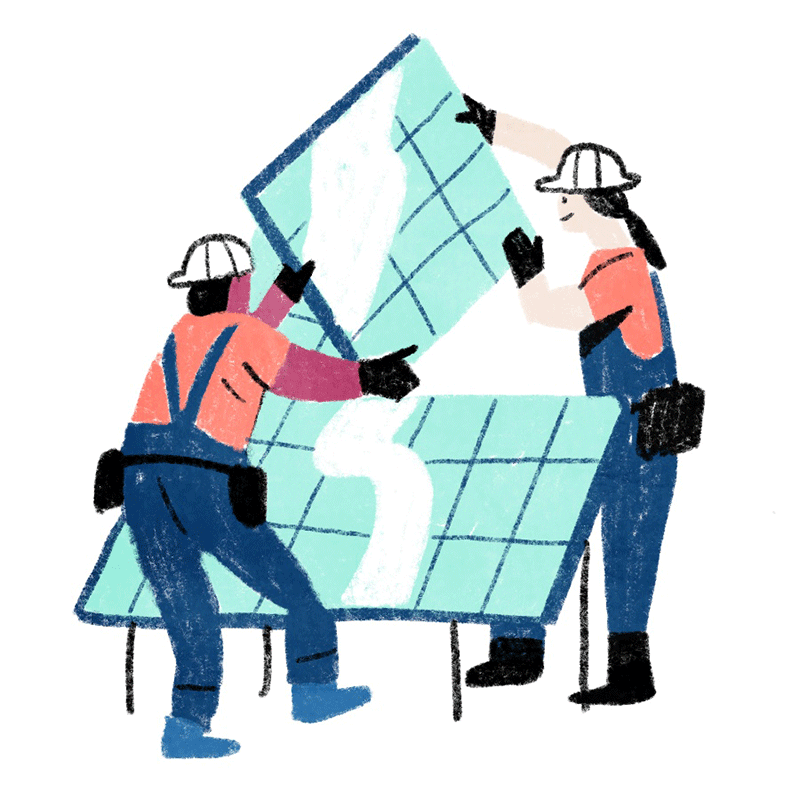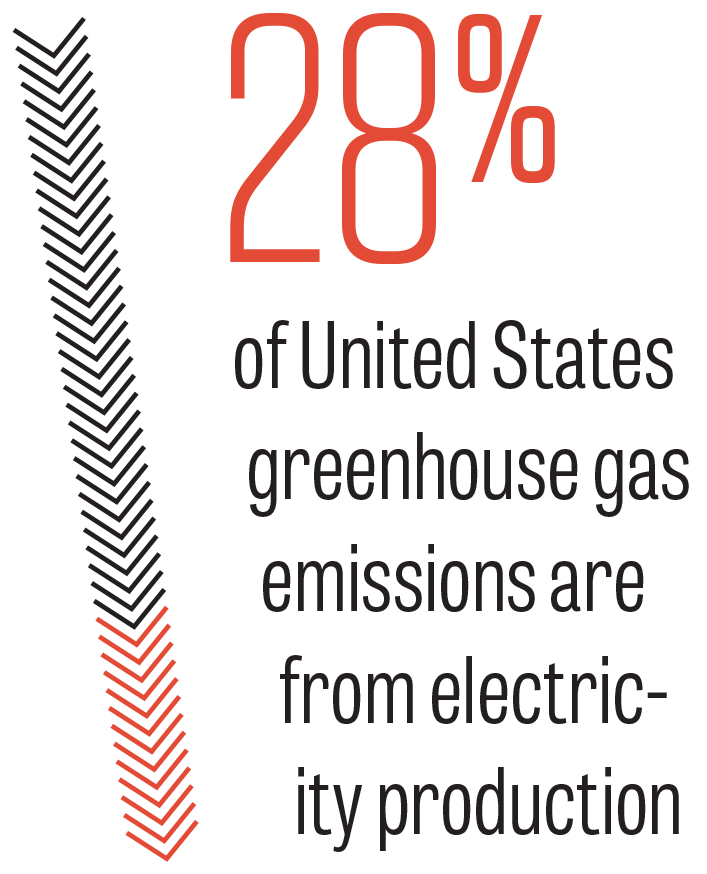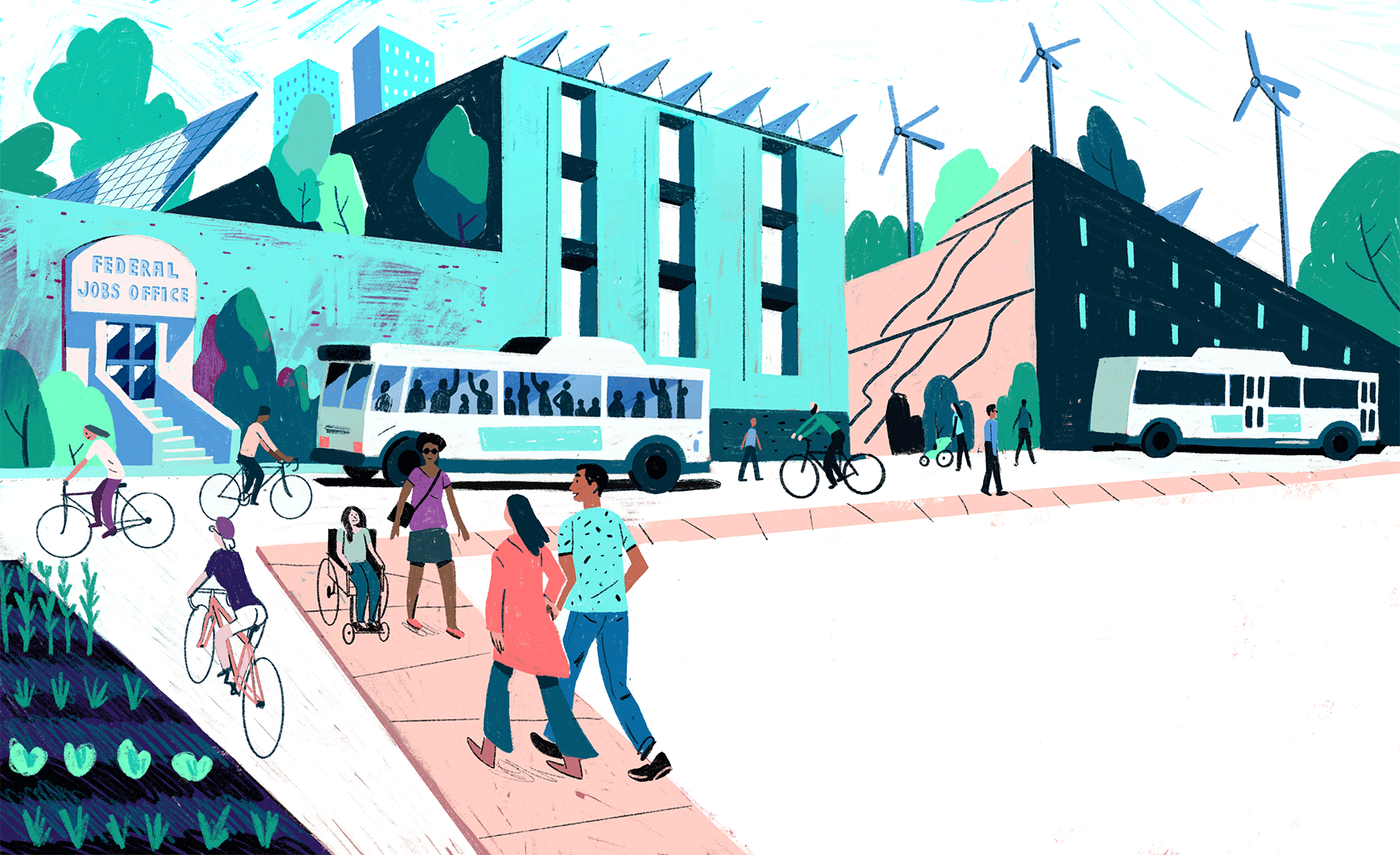Electric Companies Won’t Go Green Unless the Public Takes Control
Private electric utilities are an obstacle to climate justice. Here’s how to build alternatives.

Electric Companies Won’t Go Green Unless the Public Takes Control
Private electric utilities are an obstacle to climate justice. Here’s how to build alternatives.

April 22 | May 2019 Issue
Less than 100 years ago, electricity was far from a given for all Americans. As late as the mid-1930s, decades after most U.S. cities were fully wired, nine out of 10 rural families made do with kerosene lamps and pumped water by hand. Privately owned power companies were unwilling to invest in anything that did not produce extravagant profits, so rural communities were not prioritized. The answer—though not called by this name—was “democratic socialism.” President Franklin D. Roosevelt launched the Rural Electrification Administration (REA) in 1935 to provide tools for rural families to band together to build publicly or cooperatively owned utilities. REA brought electric power to more than 90 percent of rural America by 1953.
We need similar urgency and public action to avert climate catastrophe. The Green New Deal—which calls for a 10-year mobilization to meet 100 percent of power demand through “clean, renewable and zero-emission energy sources”—requires not just a few new green technologies, but a reimagining of the way the pieces fit together. We need a system rebuilt from the ground up with institutions of democratic, rather than private, control.
•
17 percent of our electricity came from renewables in 2018, including hydropower. Getting from here to 100 means we need to build around five to six times the renewable capacity we currently have, all while phasing out gas-powered heating and oil-fueled vehicles in favor of new, electric-powered models and increasing energy efficiency.
We know that in a warming world, we need a more resilient, smarter infrastructure to cope with the realities of extreme weather events, changing conditions and new, intermittent sources of power, like wind and solar. One key way to get there is to downsize parts of our current monolithic grid into smaller, community-sized units, interlinked but capable of operating independently in an emergency. Here, community- or neighborhood-size renewable energy installations could be owned and operated for the benefit of the communities they serve, not a giant power company’s investors.
Today’s corporate energy utilities once again stand as impediments to a viable energy future. More interested in fleecing ratepayers than in sustainability, they desperately guard their fossil fuel investments, lobby regulatory agencies and donate to preferred politicians.
The new Sunset Park Solar project in New York City is a perfect example of the sort of initiative a Green New Deal could finance across the nation. Uprose, one of the oldest community-based Latinx organizations in the city, partnered with several groups, including the state government agency NYC Economic Development Corporation, woman-owned solar installer 770 Electric and consumer-owned cooperative Co-op Power, to install community-owned solar on top of the Brooklyn Army Terminal by the end of 2019. When finished, it will serve 200 low-income residents with electricity that’s cheaper and more resilient in the face of potential climate-related grid disruption. At larger scales, different forms of democratized ownership begin to come into focus. Public ownership at the city level cuts out investors demanding higher rates and allows for long-term and holistic community investment. Residents of Boulder, Colo., have waged a multi-year struggle to take their electric utility into public ownership for the explicit goal of transitioning to clean energy. Cutting their contract with investor-owned utility Xcel would free them from the company’s historical foot-dragging on renewable energy deployment, allowing them to make their own decisions about how to transform their grid.

At the state level, campaigns to take power systems back into public hands are making strides. In California, the failures, greed and bankruptcy of the statewide grid operator, PG&E, has prompted activists to push for public ownership instead of an investor bailout. In Rhode Island, the Democratic Socialists of America’s #NationalizeGrid campaign against power company National Grid is picking up steam. In January, Rick Savage, a Republican and business owner from Bethel, Maine, responded to the possibility of a public utility quite straightforwardly: “Creating Maine Power will reduce costs to businesses like mine, put the control back in our hands, and put money back in our pockets as Mainers.”
The Green New Deal could give communities the much-needed financing, legal authority and capacity to kick out investor-owned utilities in favor of community-run, renewable-powered ones by launching a Community Ownership of Power Administration, akin to Roosevelt’s REA.
We also need to think about large-scale planning that can structurally shift entire systems to serve the many. Here, another program of the original New Deal shows what can be done: The Tennessee Valley Authority (TVA), a government-owned corporation created in 1933, was part rural electrification program, part agricultural management, part river management and part jobs program for a region of the country hit hard by poverty. A large-scale experiment in regional planning, TVA now provides wholesale energy to seven states and 10 million customers.
It should be noted that TVA backed away from an initial vision of more bottom-up democratic control, and its record on equity is far from perfect. When building its dams in the 1930s, it used eminent domain to take over farming land and failed to adequately support displaced black farmers. Its environmental record, too, is spotty, marred by large hydropower dams, nuclear and coal power.
But TVA still offers a model of the kind of large-scale planning that could today allow us to develop—in a more democratic, racially equitable and ecologically appropriate way—at-scale infrastructure designed to provide cost-effective renewable power to millions. A recent report by the People’s Policy Project proposes reforming the TVA, turning the energy juggernaut into a “Green TVA” by decarbonizing all of its energy production and expanding its service area so it can install large-scale clean energy across the country.
Imagine the windswept plains of Texas and Oklahoma with oil and fracking rigs redeveloped into centers for wind power.
Alternately, we can look to the New Deal vision of Sen. George Norris (R-Neb.), one of the original architects of the TVA, who helped make his largely conservative state the only one entirely served by public power systems. Norris urged the creation of “seven little TVAs” operating across the country as anchors of economic democracy. Such regional-scale initiatives could be leveraged to support a just transition now—with specific reflection on how to not reperpetuate the harms of the first New Deal. Imagine the windswept plains of Texas and Oklahoma with oil and fracking rigs redeveloped into centers for wind power, along with regional strategies for transitioning workers from extractive industries to renewables. And a regional consortium of cities and counties investing in publicly owned solar and storage to power communities across the Southwest. And a massive jobs program to retrofit every house in the Northeast for greater efficiency and to get it off gas heating. And fully electrified regional transit systems.
This is the level of ambition we need to make the Green New Deal work. The technology to get us to 100 percent renewables is there, according to the research of Stanford engineer Mark Z. Jacobson; the question is how we redesign the system fast enough and for the people. If our goal is to save and even improve human lives, the new system has to bake in equity and democracy at every level—from the community to the regional and beyond. 
is a research associate with The Next System Project at The Democracy Collaborative. Her work focuses on transitioning away from the extractive, fossil fuel economy and toward energy democracy.
is co-founder of The Democracy Collaborative and co-chair of The Next System Project. He is the author, most recently, of Principles of a Pluralist Commonwealth.
